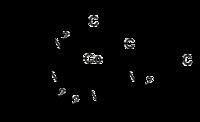Formula C4H16Cl3CoN4 | Appearance violet solid | |
 | ||
cis-dichlorobis(ethylenediamine)cobalt(III) chloride is a coordination complex with the formula [CoCl2(en)2]Cl (en = ethylenediamine). It is a violet diamagnetic solid that is soluble in water. One chloride ion in this salt readily undergoes ion exchange but the two other chlorides are less reactive, being bound to the metal center.
Contents
Synthesis
Cis-dichlorobis(ethylenediamine)cobalt(III) chloride is obtained by heating a solution of trans-[CoCl2(en)2]Cl e.g. using a steam bath. The trans isomer is in turn synthesized by the reaction of cobalt chloride and ethylenediamine in hydrochloric acid in the presence of oxygen:
4 CoCl2 + 8 en + 4 HCl + O2 → 4 trans-[CoCl2(en)2]Cl + 2 H2OThe initial product contains HCl, which is removed by heating. Alternatively, (carbonato)bis(ethylenediamine)cobalt (III) chloride reacts with hydrochloric acid at 10 °C to give the same species.
[Co(CO3)(en)2]Cl + 2 HCl → trans-[CoCl2(en)2]Cl + CO2 + H2OOptical resolution
The racemate can be resolved into two enantiomers (Λ and Δ) by the formation of the d-α-bromocamphor-π-sulfonate salt. The diastereomeric salts are separated by recrystallization. After their purification, the individual diastereomers are converted back to the chloride salt by reaction with ice cold hydrochloric acid.
Comparison of cis and trans isomers
This salt is less soluble than the dull-green isomeric trans-dichlorobis(ethylenediamine)cobalt(III) chloride (CAS#14040-33-6). This pair of isomers were significant in the development of the area of coordination chemistry. The chiral cis isomer can be obtained by heating the trans isomer. Both isomers of dichlorobis(ethylenediamine)cobalt(III) chloride have often used in stereochemical studies and as intermediates (like Tris(ethylenediamine)cobalt(III) chloride) for the preparation of other cobalt salt complexes.
The trans isomer cation has idealized D2h point group symmetry, whereas the cis isomer cation has C2 symmetry.
